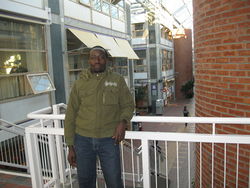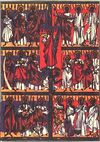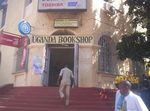Difference between revisions of "User:Misah Natumanya"
| Line 3: | Line 3: | ||
My name is Misah Natumanya, a Ugandan by nationality.I am a master's student at the Institute for Languages and Communication Studies at NTNU. Back home,I am a teaching Assistant in the Institute of Languages, Makerere University. I teach Runyakitara and some linguistics courses at undergraduate level. I enjoy morpho-syntax, morpho-semantics, phonology, translation and lexicography.I have a rich experience in translation from English to Runyankore-Rukiga, and I am among the key editors of the first ever Runyankore-Rukiga monolingual dictionary locally known as "Kashoboorozi ya Runyankore-Rukiga". Am also an author of Runyankore-Rukiga primary school thematic curriculum books, with Macmillan Publishers. I like linguistics with all my heart and soul,and believe me,this natural language database,will further our linguistic analysis. | My name is Misah Natumanya, a Ugandan by nationality.I am a master's student at the Institute for Languages and Communication Studies at NTNU. Back home,I am a teaching Assistant in the Institute of Languages, Makerere University. I teach Runyakitara and some linguistics courses at undergraduate level. I enjoy morpho-syntax, morpho-semantics, phonology, translation and lexicography.I have a rich experience in translation from English to Runyankore-Rukiga, and I am among the key editors of the first ever Runyankore-Rukiga monolingual dictionary locally known as "Kashoboorozi ya Runyankore-Rukiga". Am also an author of Runyankore-Rukiga primary school thematic curriculum books, with Macmillan Publishers. I like linguistics with all my heart and soul,and believe me,this natural language database,will further our linguistic analysis. | ||
| − | Currently, I have finished writing a thesis on '''Applicative Constructions in Runyankore-Rukiga''', It is basically on '''Runyankore-Rukiga Applicative Morpho-Phonological & Syntactic Patterns.'''. The thesis doesn't only document and investigate different forms of the applicative morpheme but also identifies and describes the Morpho-phonological rules(Processes) responsible for their realization. In the thesis text, different forms(allomorphs)of | + | Currently, I have finished writing a thesis on '''Applicative Constructions in Runyankore-Rukiga''', It is basically on '''Runyankore-Rukiga Applicative Morpho-Phonological & Syntactic Patterns.'''. The thesis doesn't only document and investigate different forms of the applicative morpheme but also identifies and describes the Morpho-phonological rules (Processes) responsible for their realization. In the thesis text, different forms (allomorphs)of the Applicative morpheme are identified and well illustrated with in-depth annotated examples from TypeCraft. Also,the thesis Classifies RR Applicative Constructions basing on the data(see my corpus below)I collected from fieldwork in 2010&2011. Syntactically,object relations and the argument structure of different classes of RR applicative constructions, are also well described and illustrated in my thesis. |
| − | The study ideally | + | The study ideally is both descriptive(being the first of its kind to document applicative constructions in Runyankore-Rukiga)and a bit analytic. Yet, description is where I started from. |
===Please also visit my corpus=== | ===Please also visit my corpus=== | ||
Revision as of 16:18, 17 June 2012
My name is Misah Natumanya, a Ugandan by nationality.I am a master's student at the Institute for Languages and Communication Studies at NTNU. Back home,I am a teaching Assistant in the Institute of Languages, Makerere University. I teach Runyakitara and some linguistics courses at undergraduate level. I enjoy morpho-syntax, morpho-semantics, phonology, translation and lexicography.I have a rich experience in translation from English to Runyankore-Rukiga, and I am among the key editors of the first ever Runyankore-Rukiga monolingual dictionary locally known as "Kashoboorozi ya Runyankore-Rukiga". Am also an author of Runyankore-Rukiga primary school thematic curriculum books, with Macmillan Publishers. I like linguistics with all my heart and soul,and believe me,this natural language database,will further our linguistic analysis.
Currently, I have finished writing a thesis on Applicative Constructions in Runyankore-Rukiga, It is basically on Runyankore-Rukiga Applicative Morpho-Phonological & Syntactic Patterns.. The thesis doesn't only document and investigate different forms of the applicative morpheme but also identifies and describes the Morpho-phonological rules (Processes) responsible for their realization. In the thesis text, different forms (allomorphs)of the Applicative morpheme are identified and well illustrated with in-depth annotated examples from TypeCraft. Also,the thesis Classifies RR Applicative Constructions basing on the data(see my corpus below)I collected from fieldwork in 2010&2011. Syntactically,object relations and the argument structure of different classes of RR applicative constructions, are also well described and illustrated in my thesis. The study ideally is both descriptive(being the first of its kind to document applicative constructions in Runyankore-Rukiga)and a bit analytic. Yet, description is where I started from.
Contents
Please also visit my corpus
My corpus consists of:
Conversations and dialogs
Newspaper excerpts
Songs
Excerpts from literary texts
Excerpts from linguistic texts



